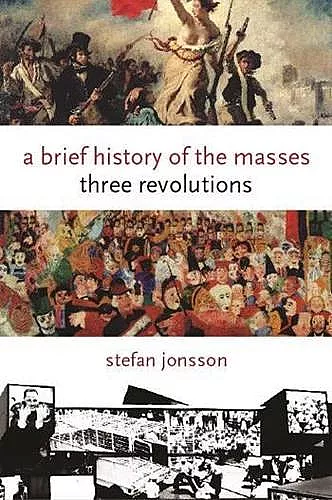A Brief History of the Masses
Three Revolutions
Format:Hardback
Publisher:Columbia University Press
Published:22nd Aug '08
Should be back in stock very soon

From his detailed analyses of three monumental works of art, Stefan Jonsson constructs an erudite and elegant meditation on the developments of modern European art and literature, out of which emerges, throughout the course of the book, an intriguing and illuminating view of the possibilities of revolution and democracy that remain for us today. -- Michael Hardt, coauthor of Empire and Multitude A Brief History of the Masses offers a surprisingly comprehensible and eloquent interdisciplinary discussion in three essays about what Stefan Jonsson defines as three revolutions: 1789, 1889, and 1989. He begins each section with a work of art and then demonstrates how that work reflects a sociological sea change, a revolution. Through the lenses of Jacques-Louis David, James Ensor, and Alfredo Jaar, Jonsson is able to raise some fundamental and fascinatingly problematic questions about the nature and future of democracy. A Brief History of the Masses is undoubtedly original, and it will most certainly cause some debate. -- Ross Shideler, professor of comparative literature and Scandinavian, University of California, Los Angeles Stefan Jonsson is one of the brightest creative minds of Europe today. I read him with flushed cheeks, impressed by his wide reading and analytical power, moved by his commitment and his courage. -- Sven Lindqvist, author of Desert Divers, Exterminate All the Brutes, and A History of Bombing
Drawing on examples from literature, politics, philosophy, and additional pieces of art, this book reveals surprising parallels between the people's political representation and their aesthetic representation.Stefan Jonsson uses three monumental works of art to build a provocative history of popular revolt: Jacques-Louis David's The Tennis Court Oath (1791), James Ensor's Christ's Entry into Brussels in 1889 (1888), and Alfredo Jaar's They Loved It So Much, the Revolution (1989). Addressing, respectively, the French Revolution of 1789, Belgium's proletarian messianism in the 1880s, and the worldwide rebellions and revolutions of 1968, these canonical images not only depict an alternative view of history but offer a new understanding of the relationship between art and politics and the revolutionary nature of true democracy. Drawing on examples from literature, politics, philosophy, and other works of art, Jonsson carefully constructs his portrait, revealing surprising parallels between the political representation of "the people" in government and their aesthetic representation in painting. Both essentially "frame" the people, Jonsson argues, defining them as elites or masses, responsible citizens or angry mobs. Yet in the aesthetic fantasies of David, Ensor, and Jaar, Jonsson finds a different understanding of democracy-one in which human collectives break the frame and enter the picture. Connecting the achievements and failures of past revolutions to current political issues, Jonsson then situates our present moment in a long historical drama of popular unrest, making his book both a cultural history and a contemporary discussion about the fate of democracy in our globalized world.
A compact yet comprehensive survey... Jonsson's globally wide-ranging and rich discussion raises important questions. Choice "From his detailed analyses of three monumental works of art, Stefan Jonsson constructs an erudite and elegant meditation on the developments of modern European art and literature, out of which emerges, throughout the course of the book, an intriguing and illuminating view of the possibilities of revolution and democracy that remain for us today. -- Michael Hardt
ISBN: 9780231145268
Dimensions: unknown
Weight: unknown
248 pages